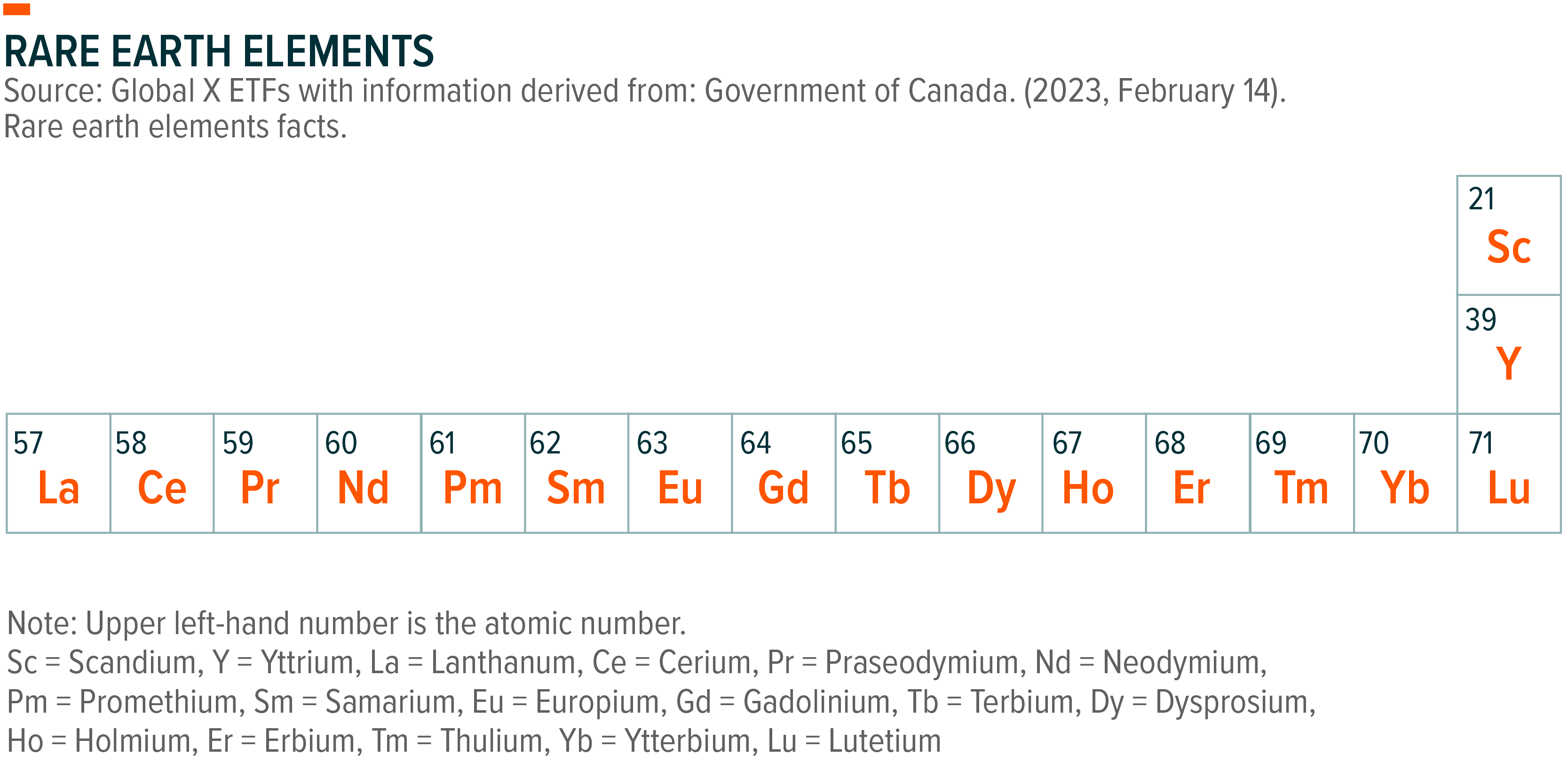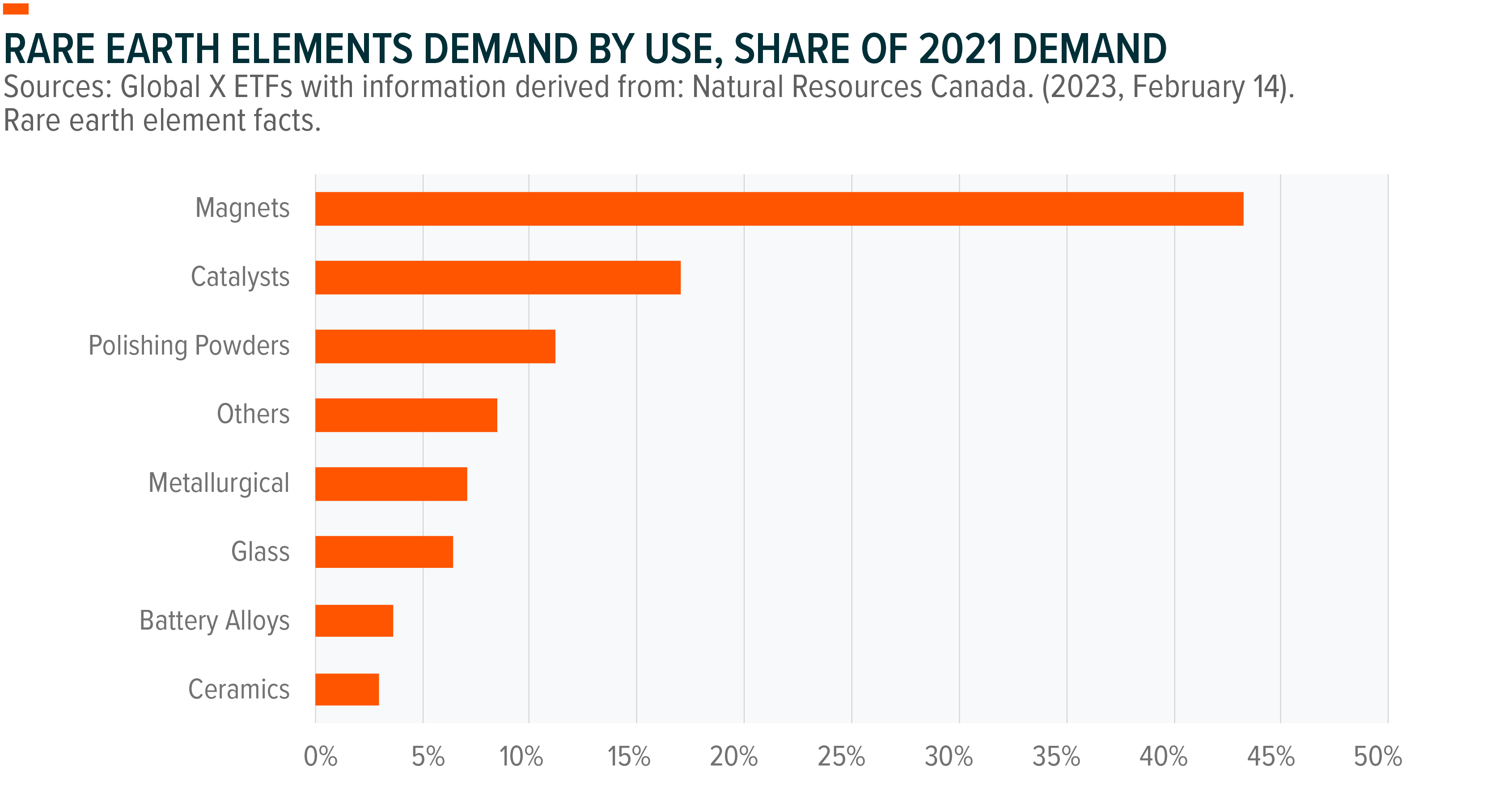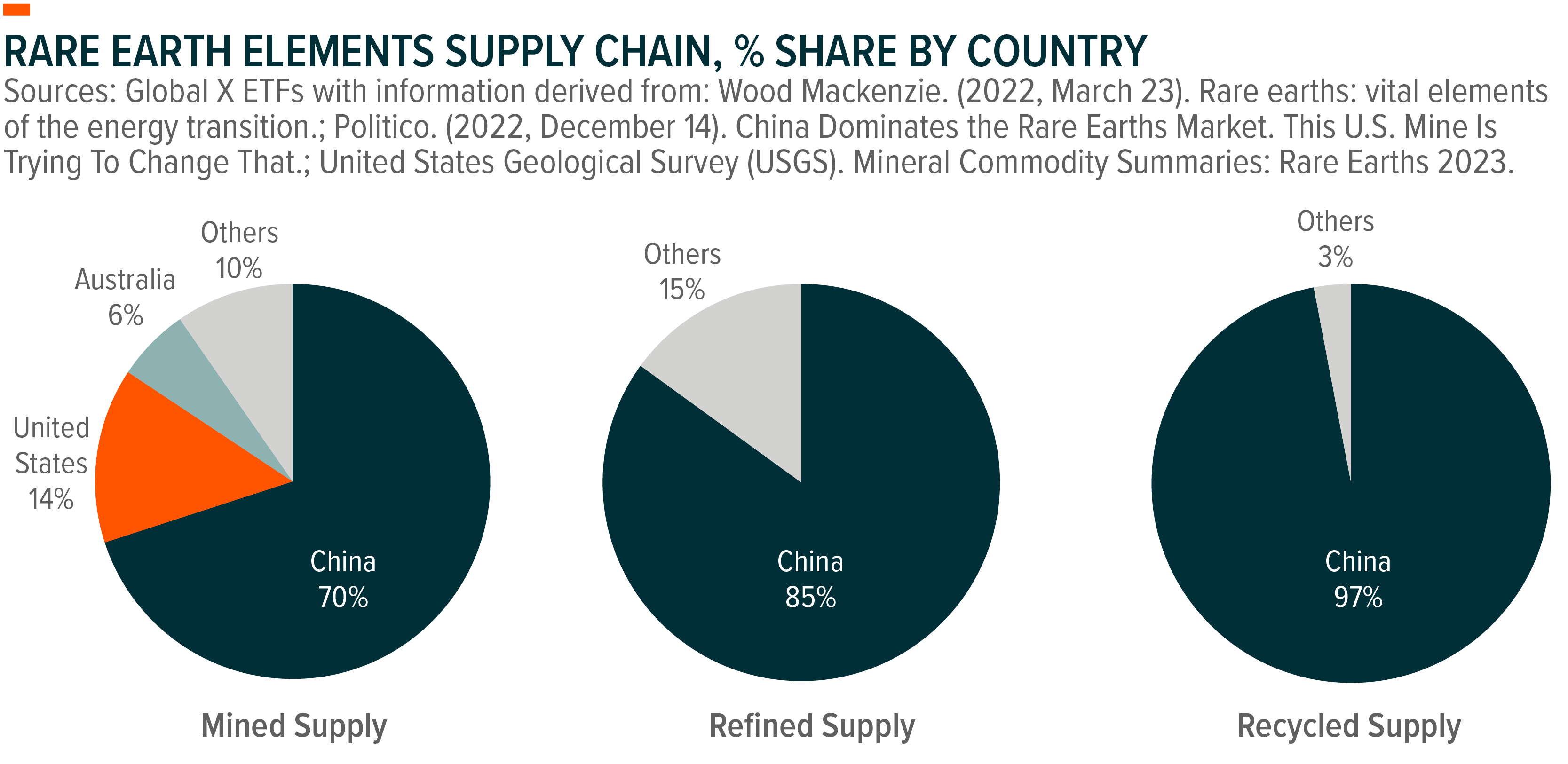Why rare earth elements are set to boom

Global X ETFs
Despite their name, rare earth elements (REEs) are a relatively abundant group of 17 metallic elements. In fact, the three most abundant REEs, cerium, lanthanum, and neodymium, are more plentiful than lead. (1) REEs’ fluorescent, conductive, and magnetic properties make them an essential component in over 200 applications and products, including disruptive digital and clean technologies such as electric vehicles (EVs), robotics, and wind turbines. (2,3)
As these technologies become more widespread, we expect that demand for REEs is likely to increase significantly. And in our view, strong demand outlooks coupled with ongoing efforts to diversify the REE global supply chain can potentially create compelling investment opportunities over the coming years.
Key takeaways
- Rare earth elements possess a unique set of properties that make them fundamental to hundreds of innovative technologies.
- Demand for REEs is forecast to reach nearly 240,000 tons by 2030, up from 171,300 tons in 2022, with key tailwinds from the digital and green transitions. (4)
- China currently dominates the REE supply chain, creating risks but also opportunities for companies in the rare earths industry.
Special properties make REEs fundamental to numerous products
The 17 rare earth elements consist of the 15-lanthanide series on the periodic table as well as scandium and yttrium. (5) These silvery-white lustrous metals are often malleable and exhibit special properties, which helps to explain why they can be utilised in a range of industrial applications. For example, neodymium, dysprosium, terbium, and samarium can be used to create some of the strongest magnets possible. Called rare earth permanent magnets, they play a crucial role in the conversion of wind power to electricity. (6) These magnets are also fundamental to the performance of most electric vehicle (EV) motors, robots, and factory automation equipment. Neodymium-iron-boron (NeFeB) magnets, the strongest commercially available rare earth magnets, are used the most in these technologies. (7)
Europium, yttrium, erbium, and neodymium are four REEs that have luminescent properties, which makes them useful for consumer technologies such as TVs and smartphones. (8,9) Cerium and lanthanum have catalytic and electrical properties that make them useful in chemical processes, catalysts, and battery technologies. (10) In short, most people use technologies that contain REEs every single day.

Long-term growth outlook for REEs is strong
The use of rare earth elements in so many technologies and products creates a strong demand growth outlook for the industry. According to one estimate, demand for rare earth oxides is forecast to increase from 171,300 metric tons in 2022 to 238,700 metric tons by 2030. (11) The increased use of rare earth magnets as part of the ongoing digital and clean energy transitions creates the most significant tailwinds for REE demand growth.
In 2021, magnets accounted for 43.2% of global REE demand. (12) Demand for NdFeB magnets is forecast to grow at a compound annual growth rate of 7.5% between 2023 and 2040. (13)
These transitions are likely to continue the clear shift in the REEs demand profile. Demand is moving away from REEs such as lanthanum and cerium, which are used in more traditional use cases like chemical process, and moving towards REEs used in magnets, such as neodymium and dysprosium.

Some cleantech companies, particularly EV and wind power equipment producers, are looking for ways to reduce or even fully eliminate REEs due to their potential environmental impacts and volatile pricing. Notably, during Tesla’s (NASDAQ: TSLA) annual Investor Day in March 2023, Colin Campbell, Tesla’s VP of Powertrain Engineering, announced that the company’s future drive unit uses a next-generation permanent magnet motor that will not use any rare earth materials. (14) Campbell offered no further details or timetables for the phaseout.
In Global X’s view, if efforts to reduce REEs by Tesla and other cleantech companies prove successful, we believe it should still have a relatively limited impact on REE demand for at least the next several years.
These are our reasons for this view:
- It is projected that reductions in the use of rare earths in wind power systems on a per megawatt of capacity basis should be outpaced by growth in overall wind power capacity through 2030. (15)
- We believe that growth in EVs could also outpace diminishing REE use in the EV industry. Non-rare earth magnets for EVs are not yet widely commercially available and generally still come at a sizeable cost in terms of weight and efficiency. (16)
- We expect that REEs’ importance in everyday electronics and other clean and digital technologies should amount to strong and diversified demand for many years to come.
Currently, the entire EV industry accounts for around 12% of rare earth magnet demand, with Tesla responsible for a little over 2%. (17)
REE supply chain dynamics present risks but also opportunities
While REEs are relatively abundant in the earth’s crust, they are often not found in large enough quantities for cost-effective mining operations. In addition, separating and processing REEs can be challenging and costly. These dynamics make the supply chain highly concentrated to only a handful of countries.
China dominates the REE supply chain, accounting for 70% of REE mining, 85% of processing, and 92% of rare earth magnet production. (18,19) China is also responsible for 97% of the recycled REE supply. (20) Therefore, many of the largest REE companies are China-based, including China Northern Rare Earth Group (HKG: 0769), China Rare Earths Resources & Technology Co. (SHZ: 000831), and Shenghe Resources Co (SHA: 600392).

China’s REE dominance creates risks for supply disruptions and price volatility.
In 2010, for example, China banned REE exports to Japan for two months, and prices spiked amid the supply disruption. (21) In April 2023, it was reported that China might prohibit exports of specific rare earth magnet technology, which could be highly disruptive over the short-term to the myriad industries that use REE magnets. (22)
However, these risks also create expansion opportunities for the REE industry.
For example, U.S.-based MP Materials (NYSE: MP) is expanding its operations to become the only fully integrated rare earths company in North America. The company, which accounted for about 15% of the global REE supply in 2021, is investing $700 million to streamline its REE processing operations and construct a rare earth metal, alloy, and magnet manufacturing facility. (23,24) Once complete, MP Materials should have the capacity to produce enough magnets for at least 500,000 EV traction motors annually, of which General Motors (NYSE: GM) is an offtaker. (25) Elsewhere, Australia-based Lynas Rare Earths (ASX: LYC) is expanding its processing efforts in the United States, Australia, and Japan to meet future demand for REEs. (26,27,28)
In the public sector, recent government initiatives aim to support the buildout of domestic REE supplies. In April 2023, the European Commission passed a Critical Raw Materials Act that aims to secure the EU’s future supply of 34 critical raw materials, including rare earths. (29) Projects that qualify can benefit from access to financing and accelerated permitting timelines. (30) In December 2022, the Canadian government published a strategy that aims to increase the supply of 31 critical minerals, also including REEs. (31)
In September 2022, the Biden Administration announced $156 million in funding from the Infrastructure Investment and Jobs Act (IIJA) and the Inflation Reduction Act (IRA) to support the U.S.’ development of a first-of-its-kind facility for extracting and separating REEs and critical minerals from unconventional sources such as mining waste. (32) In early 2022, the U.S. Department of Defense (DoD) awarded MP Materials with $35 million in funding to design and build a heavy REE processing facility at MP Materials’ California production site. (33) At the time of the announcement, the DoD had invested over $100 million in enhancing domestic REE supply chain. (34) The IRA also includes incentives to build out domestic rare earth element supply chains.
Conclusion: exposure to REEs means exposure to innovation
Expected growth in technologies such as wind turbines, robotics, and EVs is likely to lead to strong demand growth for rare earth elements over the coming years. This demand, combined with current supply dynamics and growing support from the public sector, can benefit companies across the entire REE value chain. In the process, we believe investors can find compelling opportunities in an industry that is fundamental to the ongoing clean energy and digital transitions.

